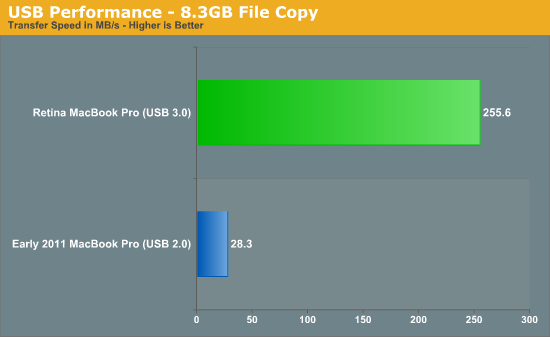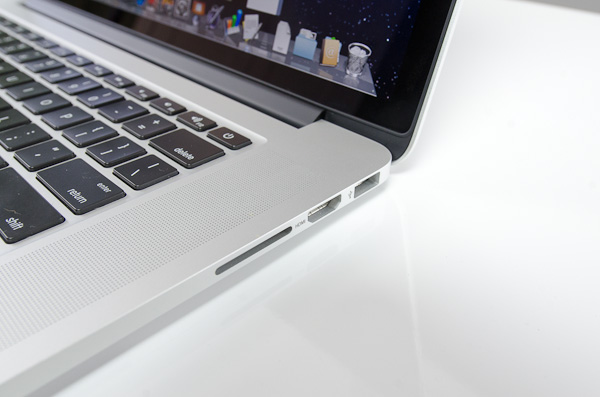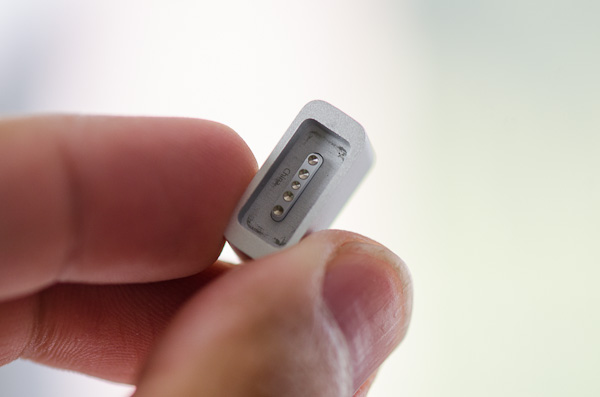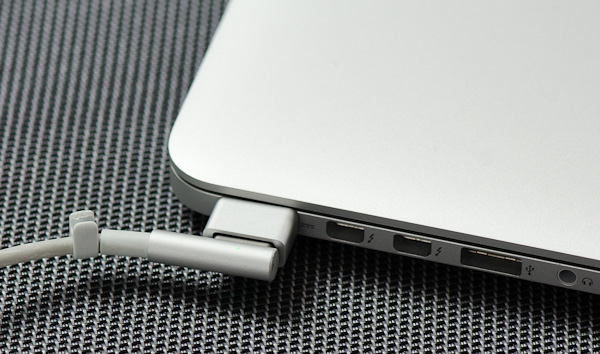The next-gen MacBook Pro with Retina Display Review
by Anand Lal Shimpi on June 23, 2012 4:14 AM EST- Posted in
- Mac
- Apple
- MacBook Pro
- Laptops
- Notebooks
Ports & Expansion
Port layout has been greatly simplified on the next-gen MacBook Pro. Along the left side there’s now a MagSafe 2 connector, two Thunderbolt ports, one USB 3.0 and one 1/8” jack for mic/headphones. The right side has the other USB 3.0 port, a full sized HDMI port and an SD card reader.
MagSafe 2 is a thinner version of Apple’s MagSafe connector, and it’s used on both the Retina MacBook Pro and the 2012 MacBook Airs. The rMBP still ships with the same 85W power adapter as before, but now with an integrated MagSafe 2 connector. In order to deal with the change in connector, Apple offers a $10 converter that allows you to plug MagSafe 1 power supplies into MagSafe 2 systems. All new Thunderbolt Displays shipping from here on out will include the MagSafe 2 converter.
The absence of an integrated Gigabit Ethernet port will surely bother some, but Apple offers a Thunderbolt to GigE adapter for $30 to accommodate. Since Thunderbolt effectively offers an external PCIe interface, there’s no performance loss if you go this route vs. the old integrated GigE connector. I was able to sustain nearly 930Mbps between the rMBP with the Thunderbolt GigE adapter and last year’s MBP:

At a price of $30 Apple is most certainly using Intel’s Port Ridge Thunderbolt controller, a cost effective single-channel TB controller without any support for DisplayPort passthrough.
USB 3.0 is provided courtesy of Intel’s 7-series chipset. Apple supports the USB Attached SCSI protocol which should allow for even better performance than what I’m showing below (with all of my focus on Thunderbolt I actually don't have a 6Gbps UASP enabled USB 3.0 dock in house):














471 Comments
View All Comments
orthorim - Wednesday, June 27, 2012 - link
A very high resolution display is not a retina display - totally different thing.Retina is a special mode where each logical pixel is made up of 4 physical pixels, and special support for fonts and images.
It's a huge step to go from 1:1 logical : physical pixels to a different factor. It's like bitmap based fonts vs. points-based vector fonts.
Maybe a lot of PC manufacturers just don't get that?
vegemeister - Monday, July 2, 2012 - link
Apple is not using a PPI independent UI for their high-res displays though. There's a separate set of assets at 2x resolution, and programs that don't acknowledge that they're rendering at 2x resolution get upscaled.A real PPI independent UI, such as Gnome 2, uses vector resources for everything and allows applications to query the PPI of the display so they can render at appropriate dimensions.
maraboshi - Saturday, June 30, 2012 - link
and still that was FAIL because it runs Windows and not a brilliant OS like the Apple one...when will you stupid Apple haters will understand the fucking difference?????gbanfalvi - Sunday, July 1, 2012 - link
I have it. It's a piece of crap. It feels like they just stuffed everything they could in this device without thinking.The pads on the bottom fell of from the heat.
The battery died seven months in.
The trackpad starts glitching regularly (not to mention it's terrible in general).
The 1080p screen gets lines across it.
The laptop overheats when I put it in speed mode.
Evidence: https://dl.dropbox.com/u/245279/Photos/Photo%20201...
azaat07 - Friday, July 13, 2012 - link
Hole in your hyperbole...Only option is Intel Graphics 4000, shared memory.
Intel 4k graphics are on par with 2007 discrete.
Andrew
woodsielord - Sunday, July 15, 2012 - link
I have the said computer. I bought it with very high expectations, and the screen is still amazing, but the rest of the hardware keeps causing trouble. I have lived without my computer 3+ months due to repairs, and currently I'm typing this from my girlfriend's Zenbook (which, on the other hand, is zero problems and all play).The lack of international Sony support and the proclimity to hardware failure rule out Sony of all my future purchases. Many times I said to myself that I should have bought a MBP instead. If Sony stopped spewing forth so many products and instead tended to the details of flagship products and cared about its customers, it might have worked.
mark3785 - Saturday, September 8, 2012 - link
Ok, I'll play the fanboy…This is where Apple haters really get pissed (and as an Apple fan from the mid 80s (and a loyalist from the 90 days from bankruptcy days) (if I'm playing the fanboi thing I may as well go whole hog) I really start to chuckle).
The MacBook Pro with retina display is proof positive that Apple can do things that the windows community can't because Apple has control of both sides of the coin, the hardware and the OS, plus (and this is a really huge plus) they have some very smart people working for them. It's one thing to put a hires display on a computer and an entirely different thing to make that display resolution independent. Sony may have come out with a hires laptop back in 2010, but they didn't do anything interesting with it.
Eventually 2880x1800 will be run of the mill and higher resolutions will start to dominate. It isn't the number of pixels, it's how the system uses them to it's best advantage. This is (hopefully) the beginning of a new trend.
BTW, one helluva review! Reviews are boring, though comforting when they state the obvious (yes, you bought a nifty machine, pat on the head) but a review this informative and complete just reinvigorates my interest in the hobby.
Targon - Saturday, June 23, 2012 - link
You need to look at the different price points that machines are sold for before you make statements like that. Most manufacturers see far greater volumes in the $500 range than they see in the $1500+ range, and it is that range that the majority of consumers look when it comes to buying a computer, either desktop or laptop.The area that manufacturers SHOULD be moving in is to make the move to a 1920x1080 display across their entire range of 14 inch and greater machines as the norm, rather than as an extra feature that people need to pay extra for if you are in the $450+ price range. Higher resolutions should be offered as the norm for higher end laptop displays. Until that happens, the PC side of the industry will seem to be inferior when it comes to display technology.
If you think about it, display technologies have been fairly stagnant except from Apple, and we have not seen an aggressive attempt to improve what we see out there. 1920x1080 displays have been the norm for too long, and going to 1920x1200 isn't enough.
OCedHrt - Sunday, June 24, 2012 - link
Check out the new Sony TTvegemeister - Monday, July 2, 2012 - link
1920x1080 should be the norm for 11".